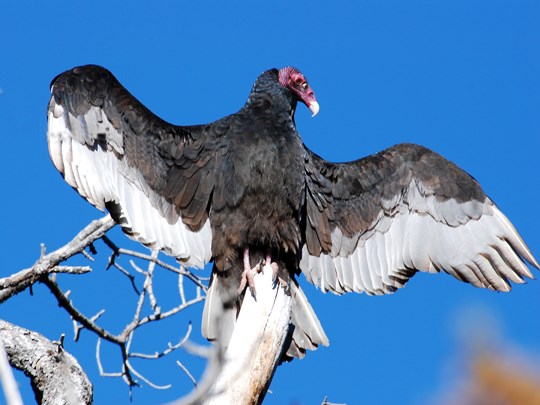
You’ve seen them circling around in the skies or picking apart a carcass on your commute — black wings that block out all light, with a tiny red speck indicating a bald, wrinkled head. They’re more like background noise in a genus of animals that includes such bombastic characters as peacocks, flamingos, western tanagers, woodpeckers, and other colorful winged beauties. No, nobody is lining up with their camera to take a picture of a turkey vulture neck-deep in the innards of roadkill to bring back home and show off to the family: “Look how it devours that whole intestine in one gulp, honey!” But don’t let their appearance or unsavory gleaning hab
its take away from the vital role they play in preventing diseases in livestock and other animals.
Turkey Vultures (much like myself) prefer to sleep in and take flight later in the day around the early afternoon. They hop and jump in a gangly, uncoordinated manner before finally taking to the skies and soaring with all the majesty of an eagle… but none of the beauty. You’ll rarely see a vulture of any kind flap its wings, they’re masters of gliding unimpeded, and this helps them perform their iconic behavior of circling about in the sky. They can maintain a high altitude for six hours without flapping their wings.
These birds are not, contrary to Looney Tunes cartoons, hovering and waiting for an animal to die, they’re finding one that’s already dead. Nor are they just using their eyes, as these vultures have an incredible sense of smell virtually unmatched in the avian sphere. When they do land, their razor-sharp hook-shaped beak tears through hide and skin to the insides of their prey. A group of vultures can make quick work of even large carcasses, expediting the decay process so that small insects can begin their part of the cycle until only bone and some ligaments are left behind.
The key to vultures being able to eat rotting flesh without contracting innumerable diseases lies in their gut microbes. Whereas human digestive systems contain hundreds of different types of tiny microbial allies, the Turkey Vulture gets by with just 75, but these are 75 of the meanest, toughest microbes you’d ever have the displeasure of meeting. Together with stomach acids that could burn your skin, the vulture digestive system acts as the ultimate waste disposal for harmful diseases that could otherwise decimate entire ecosystems if left unchecked.
Now for the fun part. Believe it or not, vultures pride themselves on keeping up appearances and being well-groomed. Basking for hours on end in the sun allows the blood and gore accumulated on their heads to shrivel, dry, and fall off leaving their scalps looking pristine and I assume in vulture eyes, attractive. Vultures preen their feathers to remove debris and remnants of their previous meals just like any other bird, but how do they keep their feet and talons so clean? Through the miracle of urohidrosis! You may know that rather than having two separate exits for solid and liquid waste, birds have a combination of the two, called a cloaca. Vultures have adapted in such a way that they can spew this mixture directly onto their feet. This serves two purposes: the bacterium in their waste helps kill off any bacteria lingering around their feet and, as it dries, it is a cooling mechanism in hot weather.
Vultures thankfully are of little concern in terms of conservation, their populations are not threatened. But I would hate to live in a world with only carrion-eating birds flying through the sky. Part of the reason vultures’ numbers are so strong is the easy accessibility of food for them. For non-carrion eating birds, natural food sources are becoming more and more scarce, just one reason for the decline of many bird species across the world. Consider lending a helping hand to birds who eat seed and suet by putting out feeders in your back yards, especially in the winter months.
Author
-

Bryce Flanagan moved from Sacramento, CA to Taos County in 2016, and has lived in Questa for two years. He's passionate about the unique and beautiful wildlife of our state and is a regular contributor to the Questa Del Rio News.
View all posts


